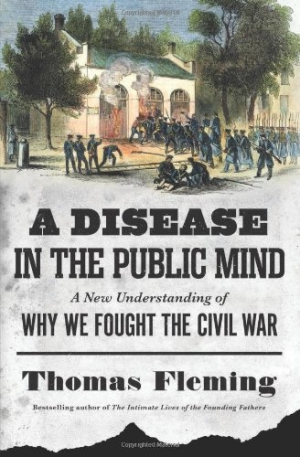A Disease in the Public Mind
A region of the country believes the federal government in Washington is undermining its culture and way of life. There is talk of war and secession. But this is not 1861, when the first blood of the Civil War was drawn. This is 1814, and the region threatening secession is New England.
While the fact that it was the North that first raised the specter of a house divided is nothing new, it is not widely remembered. Yet it is a crucial point on a timetable running from the Revolutionary War to Lincoln’s assassination, presented by historian and author Thomas Fleming, that places the blame for the Civil War on extremism by both North and South. At least, extremism is what appears to be the “disease” in his extremely captivating, yet ultimately flawed book, A Disease in the Public Mind. It is never quite clear what exactly this disease is, yet it is a theme that ties together disparate people and events in revealing ways.
When Union soldiers marched to war, they proudly sang “The Battle Hymn of the Republic,” whose lyrics taken from Revelations seemed to be God’s own exhortation to keep America whole. But the tune was taken from a song that originally drove Union men forward. It was called “John Brown’s Body,” and it glorified the memory of an abolitionist who attempted to lead a slave insurrection but succeeded only in murdering innocents. How “John Brown’s Body” became “The Battle Hymn” is symbolic of how this “disease” of extremism infiltrated Northern culture.
And so a once-rebellious New England that threatened to secede from the Union because of the federal government’s domination by slave-owning Virginians—Washington, Jefferson, Madison, Monroe—became, in a generation, stalwart patriots again.
On the other side of the Mason-Dixon Line, the Southern mind was paralyzed by a “disease” of its own. There was a pathological terror of bloody slave insurrection, a fear that dates back to the time of Thomas Jefferson, who believed the relationship between whites and blacks had been so tainted by slavery that the two races could never live together as equals. Jefferson and other Southern slave owners feared that if slaves were freed, there would be another another San Domingo, a place that struck fear in the hearts of every Southerner. Today, half of the island is known as Haiti, where in 1791, slaves living under brutal bondage revolted against their white masters and massacred many of them.
Fleming argues that slavery was on its way out, anyway. “Startling facts” have come to light in the past few decades, he writes, that paint a more subtle picture of how slavery was evolving into a kind of mini-capitalist system—with the most able and talented of slaves earning more responsibility.
The book’s focus on little-known aspects of history, such as Revolutionary War leaders who attempted to advance the cause of abolition, or former President John Quincy Adams, who spent his last years as a fervently abolitionist congressman, is fascinating and entertaining—although sprinkled with assertions that may not hold up. For example, Fleming writes that had Washington emancipated his slaves during his lifetime—rather than after his death—it would have “delivered the death blow to slavery.” This is speculation that does not hold up under scrutiny.
The argument that, had cooler heads prevailed, slavery would have slowly disappeared through a process of economic evolution, also does not necessarily follow. The Founding Fathers were convinced, too, that all they had to do was put off the question for a later generation, and slavery would fade into the barbaric past. To some extent, Fleming makes the same argument for the Civil War generation. All they had to do was wait, and slavery would have disappeared.
One simply has to look at what followed the Civil War to see that was not the case. A century later, African Americans were still being told to wait, be patient, don’t rock the boat, and their full civil rights will be granted. Instead, they had to grab it for themselves.
A century earlier, the South needed to be conquered by the North in order to force emancipation. Ultimately, Fleming fails to make the case that waiting would have achieved the same results with no bloodshed.
Still, there is much to be learned from the Civil War generation’s “disease in the public mind.” Truth is often the first victim of fanaticism in any stripe. In the North, the disease was fanatical abolitionism that failed to recognize subtlety. In the South, the disease was fear of slave insurrection. Fleming makes convincing arguments that the “disease” should be studied further. So far, though, no generation has found a cure.
Reviewed by
Howard Lovy
Disclosure: This article is not an endorsement, but a review. The publisher of this book provided free copies of the book to have their book reviewed by a professional reviewer. No fee was paid by the publisher for this review. Foreword Reviews only recommends books that we love. Foreword Magazine, Inc. is disclosing this in accordance with the Federal Trade Commission’s 16 CFR, Part 255.

